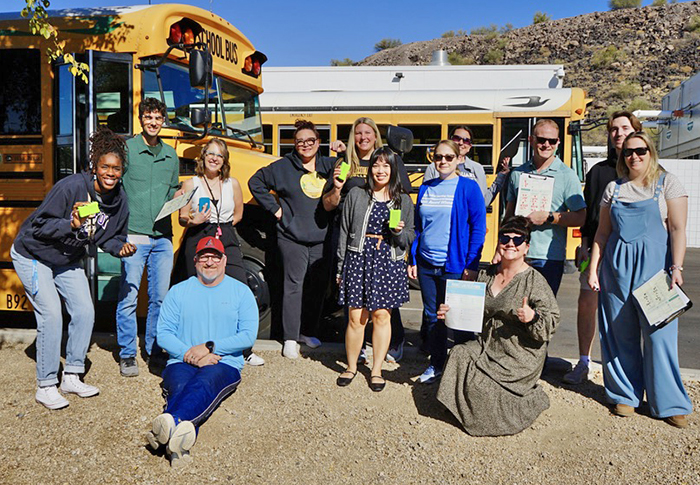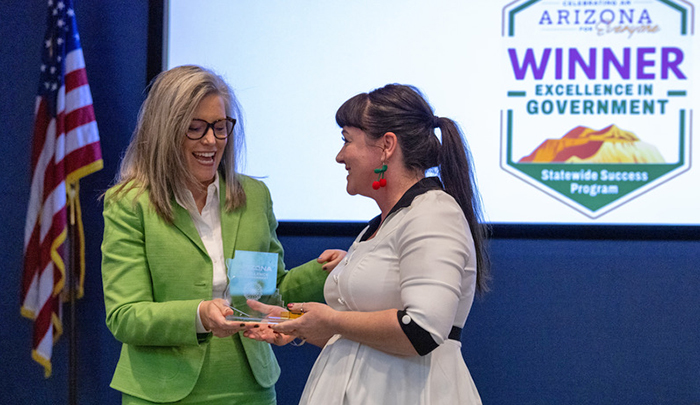
Empowering communities with participatory research
With the ever-growing challenges of addressing water security and quality, the need for innovative solutions is critical. One promising approach that combines scientific rigor with community involvement is community science.
Amber Wutich, ASU professor and lead of the Arizona Water for All program of the Arizona Water Innovation Initiative, and colleagues have developed a new online course that aims to equip individuals with the skills needed to implement and support advanced water technologies and research.
The course, freely available through ASU’s Career Catalyst program, was inspired by the groundbreaking work of Meghan Smart, a Principal Scientist at the Arizona Department of Environmental Quality (ADEQ), who has led the integration of community science with environmental monitoring efforts in Arizona.
The success of community science in Arizona
The new ASU course on participatory water methods draws heavily from the success of Smart’s work with ADEQ. In 2017, Smart, who has worked with the agency for close to two decades and still considers it “the best job ever!,” initiated a community science program, then known as Arizona Water Watch, that supported local residents in actively participating in the collection of water data.
“I spent many, many years doing surface water monitoring and mapping across Arizona. When you’re out there doing this work, you meet people who are passionate about this unique and beautiful state we live in,” Smart said. “I thought, why not add a community science program? I always equate it to the field of dreams. If you build it, they will come. And they came!”
What started as a water monitoring initiative has now expanded into the Arizona Community Science Alliance (AZCSA), a large and growing program that supports volunteers in collecting not just data on water, but also air, land and composting, and provides them with the tools, training and resources to contribute valuable knowledge that informs state decisions. This community-driven model also builds trust and strengthens the connection between the people and the data they collect.

“Community science gives people a chance to have buy-in, to be a part of the process,” Smart said. “They know the historic perspectives of these areas and can tell a better story than just a state regulatory agency coming in and doing the work.”
Since its inception, the program has seen impressive results. Volunteers have gathered over 180,000 water quality records, removed over 75,000 pounds of trash from water bodies and donated over 42,000 hours of volunteer work. ADEQ even developed an app that allows people to quickly contribute data on water flow conditions, particularly important for intermittent and ephemeral streams, with over 2,600 submissions already made. The program has also saved the state at least $5 million through volunteer data collection.
Whether it’s monitoring water quality, mapping trash or participating in air quality initiatives, the program is designed to give people the flexibility to choose their own level of involvement. “We’re trying to weave it all together,” Smart said, “balancing the needs of teachers, students and volunteers.”
What makes Smart’s work particularly impactful is its ability to extend beyond traditional scientific boundaries. A key component of the program’s success has been building partnerships with local communities, schools and even other government agencies.
“We know that we can’t do it alone,” says Smart. “By building relationships with local residents and giving them the tools and knowledge to collect credible data, we can work together to protect our environment.”
In 2021, for example, ADEQ leveraged community volunteers to collect data on the impact of the Backbone Fire on Fossil Creek, a popular recreation area. The fire had forced the closure of the stream to the public, but volunteers worked in collaboration with the U.S. Forest Service to gather invaluable data on the health of the waterway, comparing conditions before and after the fire.
“This type of collaborative research, made possible by community science, has provided key insights into the long-term effects of wildfires on water quality,” said Smart.
Another impactful example comes from a volunteer group on the Verde River who were conducting trash transects but found a more pressing problem: inexperienced kayakers frequently flipped their boats, losing plastic water bottles in the river. By collecting data on this issue, the group developed a simple, yet effective solution: attaching carabiners to the kayaks that could secure water bottles.
“This innovative idea shows how community-driven data collection can lead to real-world solutions,” said Smart, “making a tangible difference in the environment.”

Smart’s success leading the first regulatory agency community science program in the country has not gone unnoticed. In fact, her program was awarded the Governor’s Award for Excellence in Government, a testament to its innovative approach and the impact it has had on the state. But for Smart, the greatest reward is knowing that her work is making a real difference in Arizona’s communities and environments.
Learning participatory methods in water research
For Wutich, Smart’s program is not just impressive but deeply inspiring.
“We wanted to interest water professionals in using participatory methods, and there is no better example than Meghan Smart,” said Wutich. “Her work with ADEQ, getting Arizona communities involved in water science, sets an example that many of us can aspire to.”
The participatory water methods course, which was created and organized by Wutich and managed and implemented by post-doctoral researcher Cara Jacob, was born out of a partnership with the U.S. Army Corps of Engineers. The goal was to create a curriculum that could be used by water professionals nationwide to better engage communities in research. By leveraging Arizona Water Innovation Initiative support, Wutich was able to tap into a wealth of resources and connections, allowing for the development and launch of the course at ASU.
“It started with a grant to help get communities involved in Engineering With Nature in collaboration with the Army Corps,” says Wutich. “We worked with our colleagues to build a vision for a national participatory methods curriculum that would be available to engineers and other water professionals.”
Participatory methods, as taught in ASU’s course, emphasize the importance of involving those most affected by water challenges in the research process. These methods are grounded in the belief that local communities have unique insights into environmental issues and that their input can lead to more effective, sustainable solutions.
“My hope is that water professionals learn practical ways to involve communities in research,” says Wutich. “This helps community members understand the value of water research, and it enriches the research itself because it better reflects community members’ concerns and hopes for water futures.”
Developed by Wutich, Jacob and experts at both ASU and from across the country, including Anaís Roque, Melissa Beresford, Meg du Bray and Oswaldo Medina-Ramírez, the course teaches participatory methods that enable water professionals to tailor their approaches based on specific project goals. Participants can gain skills in engaging communities, using community-generated data and integrating these insights into larger management strategies.
“This course provides people with a toolkit they can use in their work,” Wutich said. “It’s not just about gathering data, but about ensuring that communities are truly engaged in the scientific process and that their insights are shaping the solutions we pursue.”
The future of community science
The success of programs like the Arizona Community Science Alliance and the new participatory methods course at ASU highlights a growing recognition of the power of community science. In Arizona, where many rural and remote areas are difficult for state agencies to monitor, local volunteers are essential partners.
“We can’t save this world unless we do it together,” Smart said. “No one has the time and resources to do it alone, but when we share knowledge, skills and equipment, we can make a real difference.”
The participatory water methods course that Wutich and collaborators have developed at ASU builds on this foundation. By teaching water professionals to incorporate participatory methods into their work, Wutich hopes to foster a new generation of researchers who are better equipped to engage with the communities they serve.
“The more we can involve people in the research process,” Wutich said, “the more effective and sustainable our solutions will be.”
Related stories:
- Empowering water leadership in southern Arizona
- Graduate student researchers addressing decentralized water systems
- Coalition building in Arizona’s water insecure communities
- Leveraging social relationships to drive meaningful change in water-insecure communities
- Arizona Water for All: Building a partner network